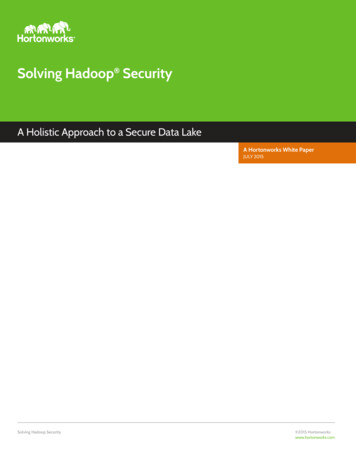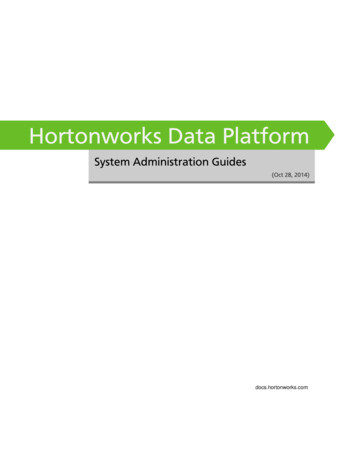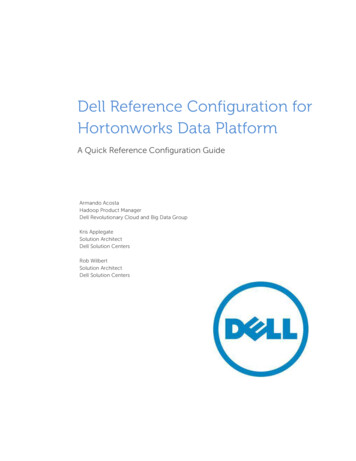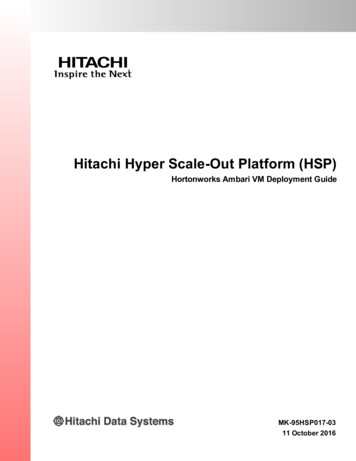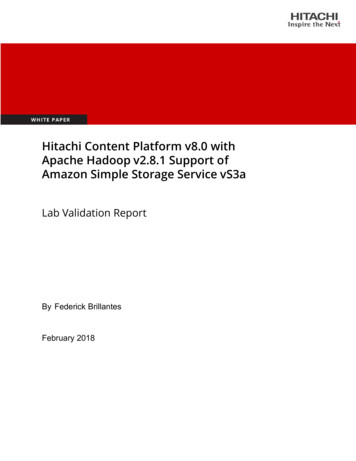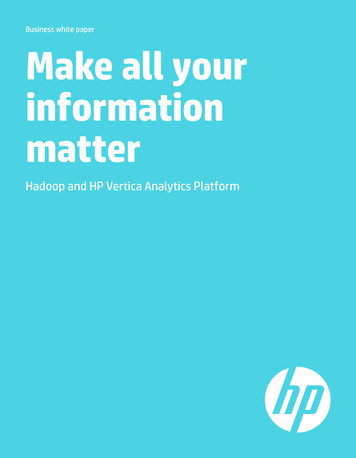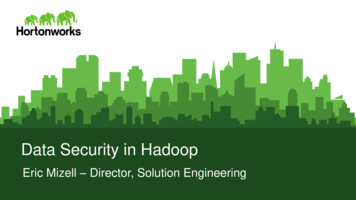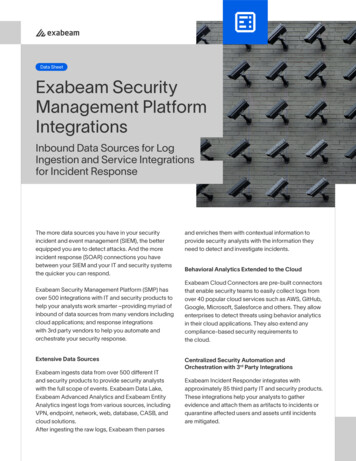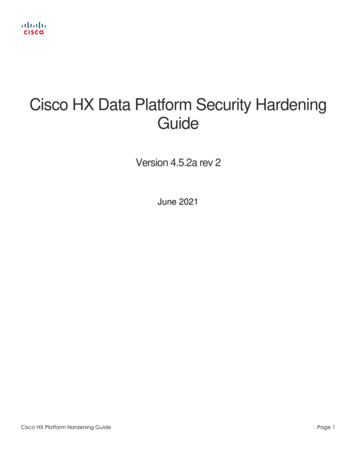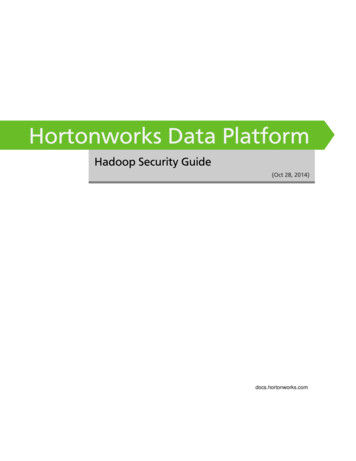
Transcription
docs.hortonworks.com
Hortonworks Data PlatformOct 28, 2014Hortonworks Data Platform : Hadoop Security GuideCopyright 2012-2014 Hortonworks, Inc. Some rights reserved.The Hortonworks Data Platform, powered by Apache Hadoop, is a massively scalable and 100% opensource platform for storing, processing and analyzing large volumes of data. It is designed to deal withdata from many sources and formats in a very quick, easy and cost-effective manner. The HortonworksData Platform consists of the essential set of Apache Hadoop projects including MapReduce, HadoopDistributed File System (HDFS), HCatalog, Pig, Hive, HBase, Zookeeper and Ambari. Hortonworks is themajor contributor of code and patches to many of these projects. These projects have been integrated andtested as part of the Hortonworks Data Platform release process and installation and configuration toolshave also been included.Unlike other providers of platforms built using Apache Hadoop, Hortonworks contributes 100% of ourcode back to the Apache Software Foundation. The Hortonworks Data Platform is Apache-licensed andcompletely open source. We sell only expert technical support, training and partner-enablement services.All of our technology is, and will remain free and open source.Please visit the Hortonworks Data Platform page for more information on Hortonworks technology. Formore information on Hortonworks services, please visit either the Support or Training page. Feel free toContact Us directly to discuss your specific needs.Except where otherwise noted, this document is licensed underCreative Commons Attribution ShareAlike 3.0 3.0/legalcodeii
Hortonworks Data PlatformOct 28, 2014Table of Contents1. Hadoop Security Features . 12. Set up Authentication for Hadoop Cluster Components . 32.1. Setting Up Security for Manual Installs . 32.1.1. Preparing Kerberos . 32.1.2. Installing and Configuring the KDC . 42.1.3. Creating the Database and Setting Up the First Administrator . 52.1.4. Creating Service Principals and Keytab Files for HDP . 62.2. Configuring HDP . 92.2.1. Configuration Overview . 92.2.2. Creating Mappings Between Principals and UNIX Usernames . 92.2.3. Adding Security Information to Configuration Files . 112.3. Configure Secure HBase and ZooKeeper . 272.3.1. Configure HBase Master . 272.3.2. Create JAAS configuration files . 292.3.3. Start HBase and ZooKeeper services . 312.3.4. Configure secure client side access for HBase . 322.3.5. Optional: Configure client-side operation for secure operation - ThriftGateway . 332.3.6. Optional: Configure client-side operation for secure operation - RESTGateway . 332.3.7. Configure HBase for Access Control Lists (ACL) . 342.4. Setting up One-Way Trust with Active Directory . 352.4.1. Configure Kerberos Hadoop Realm on the AD DC . 352.4.2. Configure the AD Domain on the KDC and Hadoop Cluster Hosts . 362.5. Allowing Impersonation . 373. Data Protection . 383.1. Enable RPC Encryption for the Hadoop Cluster . 393.2. Enable Data Transfer Protocol . 393.3. Enable SSL on HDP Components . 393.3.1. Understanding Hadoop SSL Keystore Factory . 403.3.2. Manage SSL Certificates . 423.3.3. Enable SSL for WebHDFS, MapReduce Shuffle, and YARN . 493.3.4. Enable SSL on Ozzie . 523.3.5. Enable SSL on WebHBase and the HBase REST API . 533.3.6. Enable SSL on HiveServer2 . 543.4. Connect to SSL Enabled Components . 553.4.1. Connect to SSL Enabled HiveServer2 using JDBC . 553.4.2. Connect to SSL Enabled Oozie Server . 55iii
Hortonworks Data PlatformOct 28, 2014List of Tables2.1. Service Principals . 72.2. Service Keytab File Names . 82.3. core-site.xml . 112.4. core-site.xml . 122.5. core-site.xml . 122.6. hdfs-site.xml . 132.7. yarn-site.xml . 172.8. mapred-site.xml . 192.9. hbase-site.xml . 232.10. hive-site.xml . 252.11. oozie-site.xml . 262.12. webhcat-site.xml . 273.1. Configure Data Protection for HDP Components . 393.2. Compontents that Support SSL . 403.3. Configuration Properties in ssl-server.xml . 50iv
Hortonworks Data PlatformOct 28, 20141. Hadoop Security FeaturesFor organizations that store sensitive data in the Hadoop ecosystem, such as proprietaryor personal data that is subject to regulatory compliance (HIPPA, PCI, DSS, FISAM, etc),security is essential. Many orgranizations also have to adhere to strict internal securitypolices.The Hortonworks Data Platform provides a comprehensive approach to security in thefollowing key areas: Perimeter security: HDP enables isolatation of the Hadoop cluster using a gateway andproperly configured firewall rules. HDP supports the following perimeter security: Apache Knox Gateway Gateway clients Authentication: HDP provides single authentication point for services and users thatintegrates with existing enterprise identity and access management systems. HDPSupports the following authentication services: Kerberos LDAP Local Unix System SSO (at the perimenter through Apache Knox Gateway) Authorization (Access Control): HDP provides features that allow system administratorsto control access to Hadoop data using role-based authorization. HDP supports thefollowing authorization models: Fine-grained access control for data stored in HDFS Resource-level access control for YARN Courser-grain service level access control for MapReduce Operations Table and column family level access control for HBase data, and extended ACLs forcell level control with Accumulo. Table level access control for Apache Hive data sets Accounting (Security auditing and monitoring): HDP allows you to track Hadoop activityusing Native Auditing (audit logs), perimeter security auditing logs on the Knox Gateway,and from a central location, the HDP Security Administration console, including: Access requests Data processing operations Data changes1
Hortonworks Data PlatformOct 28, 2014 Data Protection: HDP provides the mechanisms for encrypting data in flight, andrequires the use of partner solutions for encrypting data at rest, data discovery, and datamasking. HDP supports the following wire encryption methods: SSL for HDP Components RPC encryption Data Transfer Protocol2
Hortonworks Data PlatformOct 28, 20142. Set up Authentication for HadoopCluster ComponentsAuthentication: HDP provides single authentication point for services and users thatintegrates with existing enterprise identity and access management systems. HDP Supportsthe following authentication services: Kerberos LDAP Local Unix System SSO (at the perimenter through Apache Knox Gateway)2.1. Setting Up Security for Manual InstallsThis section provides information on enabling security for a manually installed version ofHDP.2.1.1. Preparing KerberosTo create secure communication among its various components, HDP uses Kerberos.Kerberos is a third-party authentication mechanism, in which users and services thatusers wish to access rely on a the Kerberos server to authenticate each to the other. Thismechanism also supports encrypting all traffic between the user and the service. TheKerberos server itself is known as the Key Distribution Center, or KDC. At a high level, it hasthe following parts: A database of the users and services (known as principals) that it knows about and theirrespective Kerberos passwords An authentication server (AS) which performs the initial authentication and issues aTicket Granting Ticket (TGT) A Ticket Granting Server (TGS) that issues subsequent service tickets based on the initialTGT.A user principal requests authentication from the AS. The AS returns a TGT that isencrypted using the user principal's Kerberos password, which is known only to theuser principal and the AS. The user principal decrypts the TGT locally using its Kerberospassword, and from that point forward, until the ticket expires, the user principal can usethe TGT to get service tickets from the TGS.Because a service principal cannot provide a password each time to decrypt the TGT, it usesa special file, called a keytab, which contains its authentication credentials.The service tickets are what allow the principal to access various services. The set of hosts,users, and services over which the Kerberos server has control is called a realm.3
Hortonworks Data PlatformOct 28, 2014NoteBecause Kerberos is a time-sensitive protocol, all hosts in the realm must betime-synchronized, for example, by using the Network Time Protocol (NTP).If the local system time of a client differs from that of the KDC by as little as 5minutes (the default), the client will not be able to authenticate.2.1.2. Installing and Configuring the KDCTo use Kerberos with HDP, either use an existing KDC or install a new one for HDP only.The following gives a very high level description of the installation process. For moreinformation, see RHEL documentation , CentOS documentation, SLES documentation. orUbuntu and Debian documentation.1. Install the KDC server: On RHEL, CentOS, or Oracle Linux, run:yum install krb5-server krb5-libs krb5-auth-dialogkrb5-workstation On SLES, run:zypper install krb5 krb5-server krb5-client On Ubuntu or Debian, run:apt-get install krb5 krb5-server krb5-clientNoteThe host on which you install the KDC must itself be secure.When the server is installed you must edit the two main configuration files, located bydefault here:2. Update the KDC configuration by replacing EXAMPLE.COM with your domain andkerberos.example.com with the FQDN of the KDC host; the configuration files arelocated: On RHEL, CentOS, or Oracle Linux: /etc/krb5.conf /var/kerberos/krb5kdc/kdc.conf. On SLES: /etc/krb5.conf /var/lib/kerberos/krb5kdc/kdc.conf On Ubuntu or Debian: /etc/krb5.conf4
Hortonworks Data PlatformOct 28, 2014 /var/kerberos/krb5kdc/kdc.conf.3. Copy the updated krb5.conf to every cluster node.2.1.3. Creating the Database and Setting Up the FirstAdministrator1. Use the utility kdb5 util to create the Kerberos database: On RHEL, CentOS, or Oracle Linux:/usr/sbin/kdb5 util create -s On SLES:[on SLES]kdb5 util create -s On Ubuntu or Debian:[on Ubuntu or Debian]kdb5 util -s createNoteThe -s option stores the master server key for the database in a stashfile. If the stash file is not present, you must log into the KDC with themaster password (specified during installation) each time it starts. This willautomatically regenerate the master server key.2. Set up the KDC Access Control List (ACL): On RHEL, CentOS, or Oracle Linux add administrators to /var/kerberos/krb5kdc/kadm5.acl. On SLES, add administrators to /var/lib/ker
28.10.2014 · 1. Hadoop Security Features For organizations that store sensitive data in the Hadoop ecosystem, such as proprietary or personal data that is subject to regulatory compliance (HIPPA, PCI, DSS, FISAM, etc), security is essential. Many orgranizations also have to
